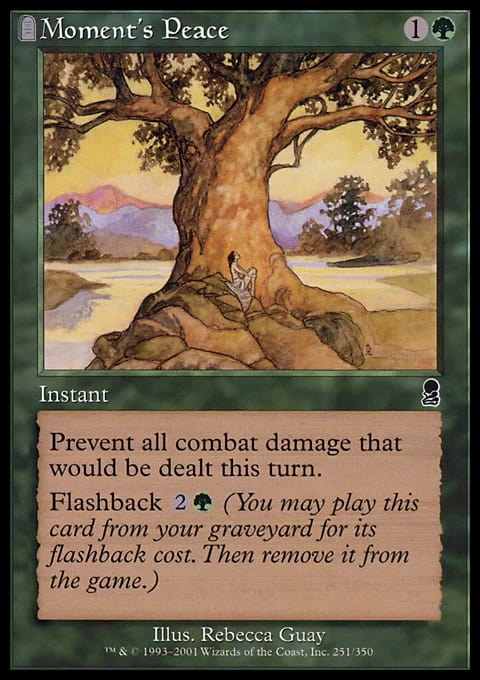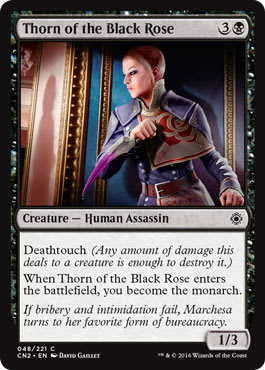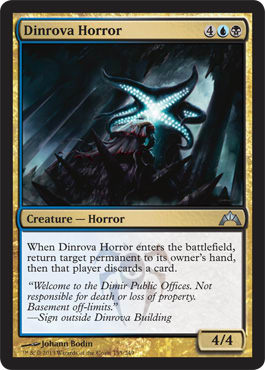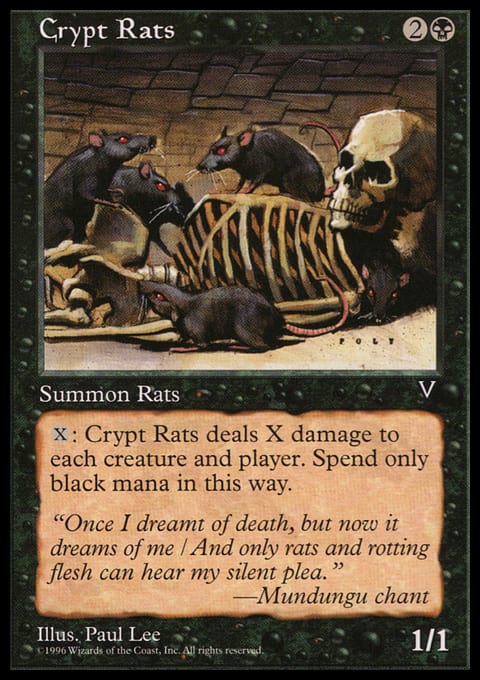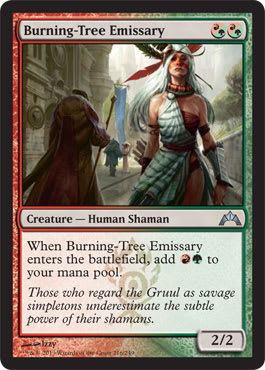A few weeks ago, Melissa DeTora wrote an excellent article on the philosophy behind balancing formats. The tenets come from the mind of Head Developer Erik Lauer and serve as guidelines for striving to create the best possible competitive environment. As is my lot in life, I took a look at these four items and attempted to apply them to Pauper. Hot on the heels of doing a deep dive on the metagame, these four principles provide another level of insight into the theoretical approach to the format. With that out of the way, let’s dive right in.
1. Decks should have interaction
Already, we are coming to a contentious criterion. In some ways, Pauper decks are filled to the brim with interactive spells. Staples such as Skred and Lightning Bolt help to define the format with their obvious power. Even with this being the case, the number of decks that actively want to interact with each other is surprisingly low. Out of the 20 decks that have won a challenge, I would consider half of them to be interactive. Izzet Delver, Boros Monarch, and Murasa Tron all attempt to play games of back and forth before establishing a winning board state. Decks like Stompy, Affinity, Elves, RallyGond, and Dinrova Tron are more about ignoring the opponent as much as possible. Some of these decks try to race to their finish (as do Tribe Combo and Izzet Blitz) while others use Moment's Peace and Prismatic Strands — cards that should be important sideboard cards — to buy time.
I want to be clear: there are plenty of interactive cards in Pauper. It just so happens a great many of them run up against the second principle of a healthy format (which we will get to shortly).
Talk about walking a tight rope. Decks should have bad matchups and there are games that should be lopsided. However when games boil down to whether or not you had the precise piece of interaction required to contend, that is when format health comes into question. Does Pauper sink to this depth? I’m not so sure.
While there are plenty of removal spells outside Skred and Lightning Bolt that see play, the others all suffer from not being either of those cards. Rather, those two are so much better than every other option, so much so that running other spells may just be a mistake. In this case, the interaction exists but it might exist in such a narrow band as that anything beyond these cards could not exist and very little would change about the metagame.
Because the road of interaction is so narrow, decks instead choose to almost completely ignore it — hence cards like Moment's Peace. The solution to this issue may reside in identifying the card (or cards) that are applying enough pressure to the metagame to force the number of viable answers down. A number of the decks that are attempting to avoid interacting are soft to Chainer's Edict style effects but these spells are at an all time low. If Chainer's Edict is a good card, it is a good sign of metagame health.
2. Decks should not be a battle of resource exchange
Formats should not come down to a battle of who has the most cards. DeTora cites a deck that starts on Force Spike and curves Counterspell into Dissipate into Dismiss while using Whispers of the Muse and Treachery to gain card economy. While some of the more powerful options are absent, these decks do indeed exist in Pauper but are hardly a dominant force. . The majority of trades in Pauper happen on a one-for-one basis; and, as such, it is hard to accrue card advantage in these exchanges. At the same time, there are fewer late game cards that allow non-control decks to come back from behind. This can make games against such decks a foregone conclusion.
When it comes to this rule, I think it is safe to say that Pauper passes if only because the power level is largely flat. It is hard to gain any sort of overwhelming card advantage without sacrificing vast amounts of time. The exception to this is the Monarch. This mechanic actively rewards you for avoiding interaction (see Rule 1) and pushes decks that include either Thorn of the Black Rose or Palace Sentinels to just go up on cards by any means necessary. Cards like Prismatic Strands and Alchemist's Vial exist to prolong the game and let the advantage garnered turned into victory through Galvanic Blast and Rally the Peasants.
3. Avoid the early/late game dichotomy
Pauper passes this test as well. While Pauper has some “late game only” decks, very few of the decks built to dominate the early game lack any form of reach. When the best aggressive deck runs Rancor, it is very hard to run out of gas.
While Pauper passes, it is not with flying colors. Because so many decks, in my estimation, ignore interaction, then the format as a whole is biased toward the early game. Right now Mulldrifter, an extremely powerful common, sees relatively little play. There is a real cost in attempting to get to the fifth turn. It is not impossible and it ties back to the emphasis on cheap removal. Pauper has become a beatdown focused format and spending the fifth turn on a single permanent can put a player too far behind to recover.
The best late game option right now may just be Dinrova Horror. The sticking point, of course, is the six mana required to get it into play. The end result is that the best Dinrova Horror decks all run the UrzaTron to try and cheat on mana. Many fall back on — you guessed it: Moment's Peace — to buy the time needed to establish a winning position.
4. All threats should have answers
Again Pauper passes, but just barely. You will be hard pressed to find a threat in Pauper that does not have an available answer. However, as I have mentioned at various other times, the lack of a good sweeper means that decks that seek to go wide do not have the same constraints on their game plan. Flooding the board and overextending has almost no negative consequence. This informs the other tests where Pauper doesn’t get stellar marks — decks focused on the early game and trending away from interactive elements.
The solution here is tougher to crack. A 3-mana sweeper a la Infest is probably too good for the format. Instead, if the games were able to take another half a turn I feel that, at the very least Crypt Rats and Evincar's Justice could make a reasonable comeback.
Pauper is not far from passing every one of these tests. The fact that it is so close is actually a testament to the format as a whole, but also the management of the ban list — one of the only tools available for curating a non-rotating format. Pauper is home to some incredibly powerful effects that facilitate these issues. Ponder and Preordain make it easy for decks seeking to assemble a small suite of cards to do just that. Yet I do not think these two are the biggest culprit at the moment.
To me, there is an overarching issue that is highlighting some of the shortcomings of Pauper. And to me that is the current dominance of Stompy.
Stompy has always been one of the best decks in the format but since the release of Modern Masters 2017 it has found itself at another level. The reason is Burning-Tree Emissary. The downshift makes it much easier for Stompy to flood the battlefield early and create a dominant board state. While it does not have the lockdown power of following up a Delver of Secrets with a Cloud of Faeries while holding up Spellstutter Sprite, Stompy can lead on Young Wolf and then present a Emissary and follow that up with a Skarrgan Pit-Skulk and Vault Skirge. While Spellstutter Sprite may have been a Spell Snare in that situation, the current sequence casts Nevermore on Pauper.
Let’s look at Stompy in the context of the rest of the format. The presence of Burning-Tree Emissary means that in order for removal decks to retain parity early they need to be able to handle multiple threats in a single turn and need to do so early. Evincar's Justice is a great sweeper but it is too slow when facing down five power on turn two, let alone another creature or two on turn three — at that point you dead by turn four. Burning-Tree Emissary in Stompy has also made it so that leaning on Chainer's Edict as removal is a mistake. Outside of Edict, using Swamps is just worse than powering your answers with Mountains; but when a deck can spit out so many threats quickly then picking off one of its controller’s choice is no way to staunch the bleeding.
So we see how the presence of Stompy can help prevent there from being effective answers (sweepers) and pushes the game toward ending early. Yet Burning-Tree Emissary also pushes the format away from interactivity. Because Stompy is so adept at enacting its game plan it has forced the format toward Red removal. It has also forced much of Pauper into race mode. Since interacting with Stompy can be a losing proposition, the correct answer is to ignore and go around. This has led to seeing more damage prevention and less removal.
What happens without Burning-Tree Emissary? This is just a thought exercise and not a call for banning, but it would allow other aggressive strategies to exist in the format. Currently the only non-Stompy beatdown deck that sees heavy play is Affinity, and that has its own combo finish. Removing the Emissary does not kill Stompy outright but instead reduces the number of “non-games” it exerts on Pauper. Losing Burning-Tree Emissary also makes it possible for Chainer's Edict and other Black spells to return, giving players more options in deck-building. It would also make cards like Crypt Rats and Evincar's Justice less risky, giving decks that only seek to flood the board some second thoughts.
The presence of Chainer's Edict would hold back Tireless Tribe-Inside Out combo and Nivix Cyclops decks which could have the added benefit of allowing some pilots to cut Fog effects in favor of interactive spells. This would have a ripple effect of making more games of back and forth Magic while also moving Pauper away from the late-early dichotomy and give other decks the opportunity to accrue resources without relying on the Monarch.
The question remains — is this a problem? I am less sure about that. Stompy has only been a dominant deck for a few months; and, with Iconic Masters only a few weeks away, it is possible that a card like Seeker of the Way can change things. Yet, the more I look at these four rules the more I realize that Pauper is getting the aristocrat’s C: a lackluster passing grade. If Iconic Masters comes and nothing changes, I am not sure Pauper will ever recover from its current tendency to slap a jet engine on a go-kart without resorting to the ban list.













